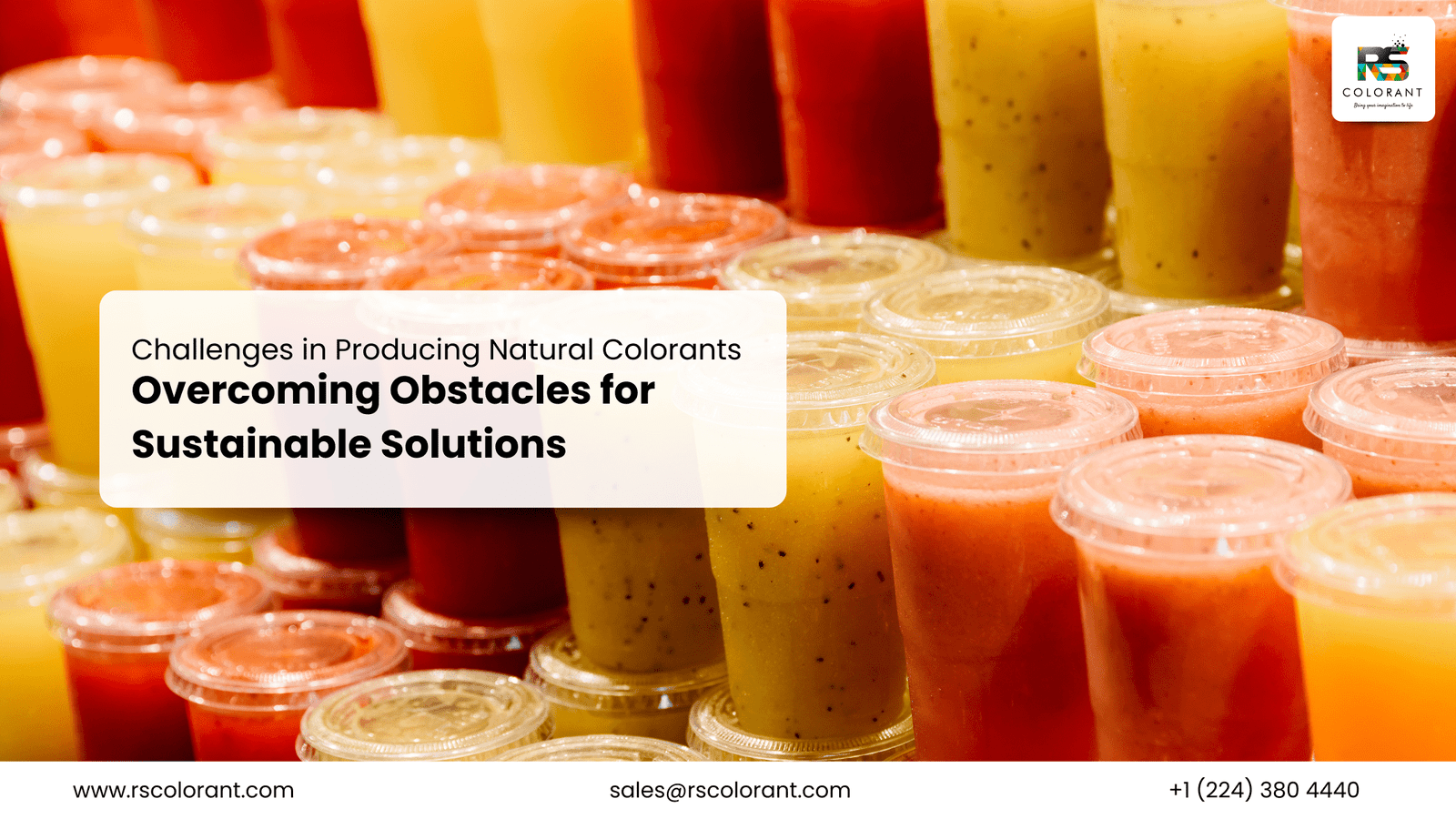Producing Natural Colorants – Outline
- Introduction
- Brief overview of natural colorants
- Importance of natural colorants in various industries
- Historical Background of Natural Colorants
- Early uses in different cultures
- Transition to synthetic colorants
- Why Shift Back to Natural Colorants?
- Health concerns with synthetic colorants
- Environmental impact of synthetic colorants
- Sources of Natural Colorants
- Plant-based sources
- Animal-based sources
- Mineral-based sources
- Extraction Methods
- Traditional extraction techniques
- Modern extraction techniques
- Quality and Consistency Issues
- Variability in raw materials
- Impact of growing conditions
- Stability and Shelf-life
- Factors affecting stability
- Preservation techniques
- Color Intensity and Fastness
- Challenges in achieving vibrant colors
- Color fastness to light, washing, and rubbing
- Cost of Production
- Economic factors
- Comparison with synthetic colorants
- Regulatory Challenges
- Compliance with food and safety regulations
- Certification processes
- Sustainability Concerns
- Environmental impact of sourcing natural colorants
- Ethical considerations in production
- Technological Advancements
- Innovations in extraction and processing
- Biotechnological approaches
- Market Demand and Consumer Preferences
- Trends in consumer behavior
- Market opportunities and challenges
- Case Studies of Successful Implementations
- Examples from the food industry
- Examples from the cosmetics industry
- Conclusion
- Summary of challenges and future outlook
The Challenges in Producing Natural Colorants
Natural colorants have been used for centuries to add vibrant hues to food, textiles, cosmetics, and more. As concerns about synthetic additives grow, there’s a renewed interest in natural alternatives. However, producing natural colorants comes with its own set of challenges. Let’s dive into the intricate world of natural colorants and explore these obstacles.
Introduction
Natural colorants are substances derived from plants, animals, or minerals that impart color to other materials. They’re crucial in various industries, from food to fashion, due to their perceived safety and eco-friendliness. Despite their benefits, producing these colorants isn’t always straightforward.
Historical Background of Natural Colorants
The use of natural colorants dates back to ancient civilizations. Egyptians used henna, while the Chinese prized their indigo dyes. However, the advent of synthetic colorants in the 19th century, offering consistent quality and vibrant colors at a lower cost, led to a decline in the use of natural alternatives.
Why Shift Back to Natural Colorants?
In recent years, there’s been a push to return to natural colorants. Why? Health concerns about synthetic colorants, linked to allergies and hyperactivity in children, have driven this change. Moreover, the environmental impact of synthetic colorants, which often involve toxic chemicals and non-renewable resources, cannot be ignored.
Sources of Natural Colorants
Natural colorants come from various sources:
- Plant-based sources: These include turmeric, beetroot, and spirulina. Plants offer a wide range of colors, from the deep reds of beets to the bright yellows of turmeric.
- Animal-based sources: Cochineal insects produce carmine, a red dye, while sepia is derived from cuttlefish.
- Mineral-based sources: Clays and earth oxides provide earthy tones and are often used in cosmetics.
Extraction Methods
Extracting colorants from natural sources can be complex:
- Traditional extraction techniques: These involve physical processes like grinding, soaking, and boiling. While straightforward, they often yield inconsistent results.
- Modern extraction techniques: Advanced methods like supercritical fluid extraction and ultrasound-assisted extraction improve efficiency and consistency but require significant investment.
Quality and Consistency Issues
One major challenge with natural colorants is the variability in raw materials. Factors such as soil quality, climate, and harvest time can affect the color and potency of the extracted dyes. This variability makes it difficult to maintain consistent quality in the final product.
Stability and Shelf-life
Natural colorants often lack the stability of their synthetic counterparts. They can degrade when exposed to light, heat, or oxygen. Preserving these colorants requires careful handling and sometimes the addition of stabilizers, which can complicate the “natural” label.
Color Intensity and Fastness
Achieving vibrant colors with natural dyes is another hurdle. Natural colorants tend to be less intense than synthetic ones. Additionally, their color fastness—resistance to fading from light, washing, or rubbing—can be poor, limiting their use in certain applications.
Cost of Production
Economically, producing natural colorants is more expensive than synthetics. The labor-intensive extraction processes and the need for large quantities of raw materials contribute to higher costs. This economic challenge often limits the adoption of natural colorants in price-sensitive markets.
Regulatory Challenges
Navigating the regulatory landscape is another significant challenge. Natural colorants used in food, cosmetics, and pharmaceuticals must meet stringent safety standards. Obtaining certification can be a lengthy and costly process, deterring small producers from entering the market.
Sustainability Concerns
While natural colorants are often marketed as environmentally friendly, their production can still have significant environmental impacts. Overharvesting plants or insects can lead to ecological imbalances. Ethical sourcing and sustainable farming practices are crucial to mitigate these concerns.
Technological Advancements
Advances in technology offer hope for overcoming some of these challenges. Innovations in extraction and processing can improve yield and consistency. Biotechnological approaches, such as genetically engineered microorganisms, are being explored to produce natural colorants more sustainably and efficiently.
Market Demand and Consumer Preferences
Consumer demand for natural and organic products is on the rise. This trend presents both opportunities and challenges for producers of natural colorants. Meeting consumer expectations for naturalness, while ensuring product quality and safety, requires balancing traditional practices with modern innovations.
Case Studies of Successful Implementations
- Food Industry: The use of beetroot powder in natural red velvet cakes or spirulina for blue candy showcases how food producers are incorporating natural colorants successfully.
- Cosmetics Industry: Brands like Lush and Burt’s Bees use plant-based colorants in their products, appealing to consumers’ desire for natural beauty solutions.
Conclusion
Producing natural colorants is fraught with challenges, from variability in raw materials to regulatory hurdles. However, the growing demand for natural and sustainable products drives innovation in this field. With technological advancements and a commitment to sustainable practices, the future of natural colorants looks promising.
FAQs
- What are natural colorants? Natural colorants are dyes derived from plants, animals, or minerals, used to add color to various products.
- Why are natural colorants preferred over synthetic ones? Natural colorants are considered safer and more environmentally friendly compared to synthetic colorants, which can have harmful health and ecological impacts.
- What are the main challenges in producing natural colorants? Challenges include variability in raw materials, stability and shelf-life issues, higher production costs, and regulatory hurdles.
- How can the stability of natural colorants be improved? Stability can be improved through advanced extraction techniques, the use of stabilizers, and proper storage conditions.
- Are natural colorants more expensive than synthetic colorants? Yes, natural colorants tend to be more expensive due to labor-intensive extraction processes and the need for large quantities of raw materials.




